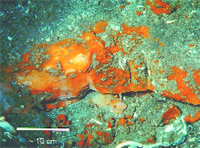 For
decades, oil companies have punched through large deposits of icy hydrocarbons
in the Gulf of Mexico to reach the regular oil and gas deposits that sit below
them. Starting this fall, after some delays, an industry-government effort will
finally begin to examine those methane hydrate deposits more carefully —
for their stability during drilling and their potential as a future energy source.
For
decades, oil companies have punched through large deposits of icy hydrocarbons
in the Gulf of Mexico to reach the regular oil and gas deposits that sit below
them. Starting this fall, after some delays, an industry-government effort will
finally begin to examine those methane hydrate deposits more carefully —
for their stability during drilling and their potential as a future energy source.
Methane hydrates mixed with gas and draped in mud sit on the seafloor of the Gulf of Mexico. Photo by Roger Sassen, Geochemical & Environmental Research Group, Texas A&M University.
The research program in the Gulf of Mexico, officially known as the Chevron Texaco-Department of Energy (DOE) Joint Industry Project, will assess the threats of drilling through unstable methane hydrate and other gas deposits, from collapsed boreholes to the potential to destabilize offshore slopes. Throughout geologic time, methane hydrates may have been responsible for large climate change and ensuing mass extinctions. Scientists have hypothesized that changing pressure and temperature or other triggers — for example, climate change or human-induced exacerbations, such as drilling a field with multiple boreholes — could destabilize methane hydrates, causing them to collapse and release large amounts of methane gas into the atmosphere.
While industry is primarily concerned with drilling safety, another key interest of the research program is whether methane and gas hydrates in the Gulf are a recoverable resource, says Mike Smith of the Department of Interior’s Minerals Management Service in New Orleans, who leads the project’s technical team concerned with seafloor stability. The conventional wisdom regarding methane hydrates globally is that “theoretically, the resource is many times the conventional gas resource — 30 times or several hundred times or more,” Smith says, “but that’s open to debate,” with regard to gas hydrate concentrations and distribution.
Funded largely by DOE, the interdisciplinary project was first broached in August 2000. ChevronTexaco organized the research in 2001, and now more than half a dozen companies and agencies participate, including Japan National Oil Company, Halliburton, India’s Reliance Industries and TotalFinaElf.
The drilling in the Gulf of Mexico will take place near mounds and other geologic features associated with known methane hydrate deposits, and the project’s ultimate goal will be to correlate subsurface gas hydrate deposits to seismic profiles of the region. Historically, companies drilled quickly to save time and money and thus have not obtained detailed logging of the upper layers containing methane hydrates; thus until now, such data have been unavailable.
Also, Smith says, the industry drill holes are too wide for accurate and detailed data gathering. Smaller drill holes for the Joint Industry Project will allow a variety of methods to collect proxies, such as temperature and pressure profiles, for sediment and gas characterization at a higher resolution.
Originally scheduled for early May, drilling has been pushed back until at least September, according to Stephen Holditch of Texas A&M University in College Station, who gave a progress report in April at the American Association of Petroleum Geologists (AAPG) meeting in Dallas. Holditch said that required permits had yet to be issued by the Environmental Protection Agency. Smith of MMS expects the permits to come through by the end of the summer. He says the delay comes over concerns regarding discharge of mud and drill cuttings from the proposed drill sites.
The lengthy timeframe for the project has frustrated some people in the academic community because of different expectations than from those involved on the industry side, says Lesli Wood of the Bureau of Economic Geology in Austin, Texas. However, in this “marriage” between academia and industry, “the advantages outweigh the disadvantages.” Preliminary studies from both academia, including key work at Texas A&M, and industry have supported the drilling project. For example, researchers at Georgia Tech presented results at the AAPG meeting on monitoring heat flow in Gulf of Mexico sediments, for predicting the potential extent and volume of methane hydrates. And U.S. Geological Survey researchers have gathered seismic data that have assisted in selecting drill sites in the Gulf.
Substantial DOE funding will allow the results to be publicly available once complete.
Naomi Lubick
Back to top

